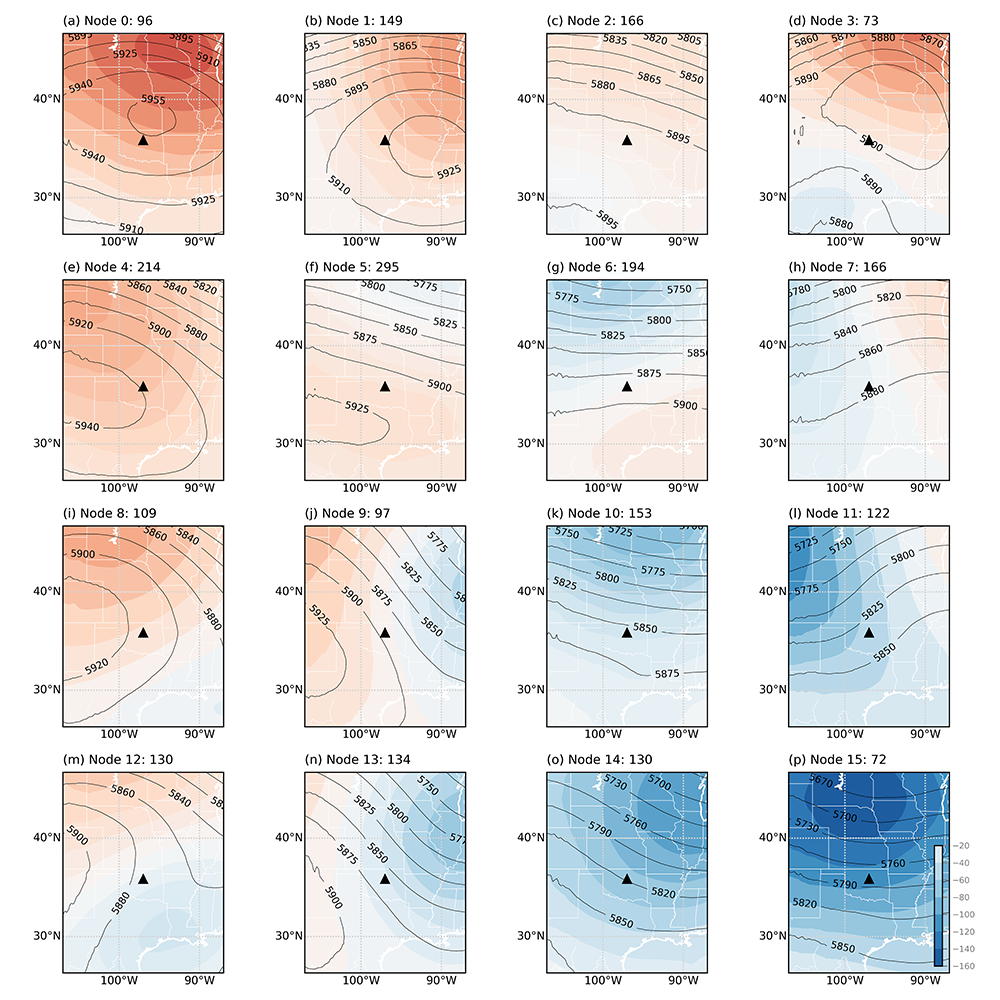New Synoptic Weather Regime Classification Product Ready for Evaluation
Published: 10 September 2025

The Atmospheric Radiation Measurement (ARM) User Facility has released a new machine learning value-added product (VAP) called Synoptic Weather Regime Classification (SynopWeaReg).
This VAP provides key insights into the variability of large-scale circulations in a region. It helps reveal how these weather patterns influence cloud formation, aerosol transport, and other atmospheric features over the area and provides broader context for the ARM site observations. The product also assists researchers in identifying specific weather regimes for their studies, such as selecting cases of interest and examining multiple cases under similar large-scale conditions, which can be useful for model evaluation and parameterization development. This approach provides an avenue to isolate the effects of large-scale weather conditions on atmospheric processes of interest, including their impacts on aerosol-cloud-precipitation relationships.
SynopWeaReg is now available as an evaluation VAP for the entire Green Ocean Amazon (GoAmazon2014/15) field campaign near Manacapuru, Brazil, and the June–September 2022 intensive operational period of the TRacking Aerosol Convection interactions ExpeRiment (TRACER) near Houston, Texas. It is also available in evaluation mode for the Southern Great Plains (SGP) atmospheric observatory during the summers (June, July, and August) of 2000 to 2024.
To create this VAP, the ARM translator team at Brookhaven National Laboratory in New York applied a self-organizing map (SOM), an unsupervised machine learning approach, to training data sets to classify the dominant synoptic weather regimes in the GoAmazon, TRACER, and SGP regions. The training data sets consisted of historical European Centre for Medium-Range Weather Forecasts Reanalysis version 5 (ERA5) data, including daily geopotential height anomalies—geopotential heights minus the mean state values during the training data period—at a specific time, for each region of interest.
Information about the training data and regime classification for each region is below. The nodes are categories outputted directly by the SOM method, and the number of nodes is defined based on a solution that optimizes the training errors.
| Region | Training Data Coordinates | Training Data Years | Training Data Season(s) | Daily Geopotential Height Anomalies at xx:00 UTC (Coordinated Universal Time) | Regime Classification |
| GoAmazon | 10°N, 50°S, 30°W, 90°W | 2000–2019 | Whole year | 500 hPa at 04:00 | Nodes 11, 12, 13, 14, and 15: wet regime Nodes 0, 1, 2, 3, 4, 5, 8, and 9: dry regime Nodes 6, 7, and 10: transitional regime |
| TRACER | 20°N, 40°N, 110°W, 85°W | 2010–2022 | Summer (June 1–September 30) | 700 hPa at 00:00 | Nodes 0, 1, 2, and 4: post-trough regime Nodes 3, 7, 11, and 15: pre-trough regime Nodes 8, 12, 13, and 14: anticyclonic regime Nodes 5, 6, 9, and 10: transitional regime |
| SGP | 26°N, 46°N, 107°W, 87°W | 2000–2024 | Summer (June 1–August 31) | 500 hPa at 00:00 | Nodes 7, 11, and 15: pre-trough regime Nodes 9, 12, 13, and 14: post-trough regime Nodes 5, 6, and 10: zonal regime Nodes 0, 1, 2, 3, 4, and 8: anticyclonic regime |
SynopWeaReg provides a single file that identifies the dominant weather regime and SOM node for each day in a specified period.
This VAP is planned to cover all ARM sites in the future, with the next data release slated for the Bankhead National Forest observatory.
More information about SynopWeaReg can be found on the VAP web page.
Access the SynopWeaReg data in the ARM Data Center. (To download the data, first create an ARM account.) The individual data products for each region are listed as synopweareg2015ml (GoAmazon), synopwearegjjas2022ml (TRACER), and synopwearegjja2024ml (SGP).
To ask questions, provide feedback, or report data issues before this evaluation VAP moves to production, please contact ARM interim translator Scott Giangrande or VAP developer Aifang Zhou.
SynopWeaReg data can be referenced as doi:10.5439/2564725 for GoAmazon, doi:10.5439/2532317 for TRACER, and doi:10.5439/2569364 for the SGP.
Keep up with the Atmospheric Observer
Updates on ARM news, events, and opportunities delivered to your inbox
ARM User Profile
ARM welcomes users from all institutions and nations. A free ARM user account is needed to access ARM data.


















